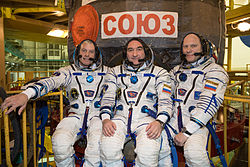Sojus TMA-12M
| Missionsdaten | |||
|---|---|---|---|
| Mission | Sojus TMA-12M | ||
| Raumfahrzeug | Sojus 7K-STMA-Z (GRAU-Index 11F747) Seriennummer 712 | ||
| Rufzeichen | Утёс („Felsen“)[1] | ||
| Trägerrakete | Sojus FG (GRAU-Index 11A511FG) | ||
| Besatzung | 3 | ||
| Start | 25. März 2014, 21:17 UTC | ||
| Startplatz | Baikonur 1/5 | ||
| Raumstation | ISS | ||
| Andockplatz | Poisk | ||
| Ankopplung | 27. März 2014, 23:53 UTC | ||
| Abkopplung | 10. September 2014, 23:01 UTC | ||
| Dauer auf ISS | 166d, 23h, 08min | ||
| Landung | 11. September 2014, 02:23 UTC | ||
| Landeplatz | 149 km SO von Scheskasgan, Kasachstan 47° 19′ N, 69° 33′ O | ||
| Flugdauer | 169d 05h 06min | ||
| Erdumkreisungen | 2626 | ||
| Mannschaftsfoto | |||
 Steven Swanson, Alexander Skworzow, Oleg Artemjew | |||
| ◄ Vorher / nachher ► | |||
| |||
Sojus TMA-12M ist eine Missionsbezeichnung für den Flug des russischen Raumschiffs Sojus zur Internationalen Raumstation. Im Rahmen des ISS-Programms trägt der Flug die Bezeichnung ISS AF-38S. Es war der 38. Besuch eines Sojus-Raumschiffs an der ISS und der 144. Flug im Sojusprogramm.
Besatzung
Hauptbesatzung
- Alexander Alexandrowitsch Skworzow (2. Raumflug), Kommandant, (Russland/Roskosmos)
- Oleg Germanowitsch Artemjew (1. Raumflug), Bordingenieur, (Russland/Roskosmos)
- Steven Ray Swanson (3. Raumflug), Bordingenieur, (USA/NASA)
Ersatzmannschaft
- Alexander Michailowitsch Samokutjajew (2. Raumflug), Kommandant, (Russland/Roskosmos)
- Jelena Olegowna Serowa (1. Raumflug), Bordingenieurin, (Russland/Roskosmos)
- Barry Eugene Wilmore (2. Raumflug), Bordingenieur, (USA/NASA)
Missionsbeschreibung
Die Mission brachte drei Besatzungsmitglieder der ISS-Expeditionen 39 und 40 zur Internationalen Raumstation.[2]
Sojus TMA-12M sollte planmäßig im „Express-Modus“, also nach sechs Stunden oder vier Erdumläufen an der ISS ankoppeln. Die dazu nötigen zwei ersten Triebwerkszündungen fanden ordnungsgemäß statt. Die dritte Zündung blieb wegen inkorrekter Bahndaten aus. Daraufhin entschieden sich die russischen Flugkontrolleure für den herkömmlichen Anflug über einen Zeitraum von zwei Tagen. Die Annäherung an die ISS, die Kopplung und das Umsteigen der Raumfahrer erfolgten dann ohne Probleme.[3]
Am 10. September 2014 um 23:01 UTC koppelte Sojus TMA-12M mit Skworzow, Artemjew und Swanson an Bord ab. Damit begann auf der ISS die Expedition 41 mit Maxim Surajew als Kommandant. Der Deorbit Burn fand um 1:30 UTC am 11. September statt und brachte die Raumkapsel um 2:01 UTC in die dichteren Bereiche der Erdatmosphäre. Die Landung erfolgte dann um 2:23 UTC 149 km südöstlich von Scheskasgan pünktlich und zielgenau in der Steppe Kasachstans.[4]
Galerie
Siehe auch
Weblinks
- Sojus TMA-12M bei space.kursknet.ru (englisch/russisch, archiviert 2016)
- Sojus TMA-12M im NSSDCA Master Catalog (englisch)
- Sojus TMA-12M bei spacefacts.de
- Sojus TMA-12M im Russian Space Web
- Sojus TMA-12M in der Encyclopedia Astronautica (englisch)
Einzelnachweise
- ↑ Позывные экипажей советских/российских космических кораблей. astronaut.ru, 14. Juni 2013, abgerufen am 18. Juni 2013 (russisch).
- ↑ Планируемые полёты. astronaut.ru, 12. Juni 2013, abgerufen am 18. Juni 2013 (russisch).
- ↑ Günther Glatzel: Sojus-TMA 12M an ISS gekoppelt. raumfahrer.net, 28. März 2014, abgerufen am 28. März 2014.
- ↑ Soyuz TMA-12M - Mission Updates. Spaceflight101, 11. September 2014, archiviert vom Original am 12. September 2014; abgerufen am 11. September 2014 (englisch).
Auf dieser Seite verwendete Medien
Backdropped by a blanket of clouds, the Soyuz TMA-7 spacecraft departs from the International Space Station carrying astronaut William S. (Bill) McArthur Jr., Expedition 12 commander and NASA space station science officer; Russian Federal Space Agency cosmonaut Valery I. Tokarev, flight engineer; and Brazilian Space Agency astronaut Marcos C. Pontes. Undocking occurred at 2:48 p.m. (CDT) on April 8.
The Soyuz TMA-12M spacecraft is rolled out to the launch pad by train on Sunday, March 23, 2014, at the Baikonur Cosmodrome in Kazakhstan. Launch of the Soyuz rocket is scheduled for March 26 and will send Expedition 39 Soyuz Commander Alexander Skvortsov of the Russian Federal Space Agency, Roscosmos, Flight Engineer Steven Swanson of NASA, and Flight Engineer Oleg Artemyev of Roscosmos on a six-month mission aboard the International Space Station.
In the Integration Facility at the Baikonur Cosmodrome in Kazakhstan, Expedition 39/40 Flight Engineer Steve Swanson of NASA (left), Soyuz Commander Alexander Skvortsov of the Russian Federal Space Agency or Roscosmos (center) and Flight Engineer Oleg Artemyev of Roscosmos pose for pictures March 14 following a fit check dress rehearsal that is part of crew training. Swanson, Skvortsov and Artemyev are scheduled to launch to the International Space Station March 26 (Kazakh time) for the start of a six-month mission.
Other 3 new crew mates have arrived.
A view from the International Space Station shows the Soyuz TMA-12M spacecraft shortly before docking of the two orbiting vehicles. Onboard the Soyuz at this time were incoming Expedition 39 crew members – Soyuz Commander Alexander Skvortsov of the Russian Federal Space Agency (Roscosmos), Flight Engineer Steve Swanson of NASA and Flight Engineer Oleg Artemyev of Roscosmos. Onboard the orbiting complex were Expedition 39 Commander Koichi Wakata of the Japan Aerospace Exploration Agency (JAXA), Flight Engineer Rick Mastracchio of NASA and Flight Engineer Mikhail Tyurin of Roscosmos.
The Soyuz TMA-12M rocket launches from Baikonur Cosmodrome in Kazakhstan on Wednesday, March 26, 2014 carrying Expedition 39 Soyuz Commander Alexander Skvortsov of the Russian Federal Space Agency, Roscosmos, Flight Engineer Steven Swanson of NASA, and Flight Engineer Oleg Artemyev of Roscosmos to the International Space Station.
The Soyuz TMA-12M spacecraft departs from the International Space Station and heads toward a landing in a remote area near the town of Zhezkazgan, Kazakhstan. NASA astronaut Steve Swanson, Expedition 40 commander; Russian cosmonaut Alexander Skvortsov, Soyuz commander and flight engineer; and Russian cosmonaut Oleg Artemyev, flight engineer, are returning from more than five months aboard the space station where they served as members of the Expedition 39 and 40 crews. Landing occurred at 10:23 p.m. (EDT), Sept. 10, 2014 (8:23 a.m., Sept. 11, Kazakh time).












